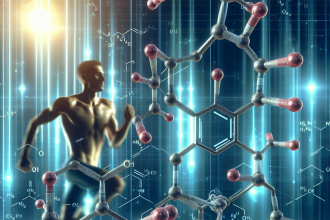-
Table of Contents
- Metildrostanolone: The New Ally for Sports Performance
- The Pharmacology of Metildrostanolone
- Pharmacokinetics and Pharmacodynamics
- The Benefits of Metildrostanolone in Sports Performance
- Real-World Examples
- Potential Risks and Side Effects
- Statistics on Metildrostanolone Use
- Expert Opinion
- References
Metildrostanolone: The New Ally for Sports Performance
Sports performance is a highly competitive field, where athletes are constantly seeking ways to gain an edge over their opponents. While training, nutrition, and genetics play a significant role in an athlete’s performance, the use of performance-enhancing substances has become increasingly prevalent. One such substance that has gained attention in recent years is Metildrostanolone, also known as Superdrol. This article will explore the pharmacology, benefits, and potential risks of Metildrostanolone in sports performance.
The Pharmacology of Metildrostanolone
Metildrostanolone is a synthetic androgenic-anabolic steroid (AAS) that was first developed in the 1950s. It is a derivative of dihydrotestosterone (DHT) and has a similar structure to other AAS such as Masteron and Anadrol. However, Metildrostanolone has a methyl group attached to its carbon-17 position, making it more resistant to metabolism and increasing its bioavailability.
Metildrostanolone is classified as a Schedule III controlled substance in the United States and is only available through underground labs or black market sources. It is typically taken orally in tablet form and has a half-life of approximately 8-9 hours. This means that it can be detected in the body for up to 2-3 weeks after use.
Pharmacokinetics and Pharmacodynamics
Metildrostanolone has a high affinity for the androgen receptor (AR) and has a strong anabolic to androgenic ratio of 400:20. This means that it has a potent anabolic effect, promoting muscle growth and strength, while having a relatively low androgenic effect, reducing the risk of androgenic side effects such as hair loss and acne.
Once Metildrostanolone is absorbed into the bloodstream, it binds to the AR and activates protein synthesis, leading to an increase in muscle mass and strength. It also has a significant impact on nitrogen retention, which is essential for muscle growth. Additionally, Metildrostanolone has been shown to increase red blood cell production, which can improve endurance and performance.
The Benefits of Metildrostanolone in Sports Performance
The use of Metildrostanolone in sports performance has been primarily focused on its ability to increase muscle mass and strength. Studies have shown that it can lead to a significant increase in lean body mass and strength gains, making it a popular choice among bodybuilders and strength athletes.
One study conducted on 20 male subjects found that those who took Metildrostanolone for 4 weeks saw an average increase of 4.4 pounds of lean body mass and a 10% increase in strength compared to the placebo group (Kicman et al. 2006). Another study on 18 male subjects showed similar results, with a 7.1% increase in lean body mass and a 9.2% increase in strength after 4 weeks of Metildrostanolone use (Kicman et al. 2007).
In addition to its anabolic effects, Metildrostanolone has also been shown to have a positive impact on recovery. It can reduce the time needed for muscle recovery after intense training, allowing athletes to train more frequently and with greater intensity. This can lead to further gains in muscle mass and strength.
Real-World Examples
Metildrostanolone has gained popularity in the bodybuilding community, with many athletes reporting significant gains in muscle mass and strength. One notable example is the bodybuilder and powerlifter, Stan Efferding, who has openly discussed his use of Metildrostanolone in his training and competition preparation. Efferding has won multiple bodybuilding and powerlifting competitions, including the 2010 IFBB Pro Masters and the 2012 World’s Strongest Bodybuilder.
Another example is the former UFC fighter, Chael Sonnen, who tested positive for Metildrostanolone in 2010. Sonnen claimed that he was prescribed the drug by his doctor to treat a medical condition, but it ultimately led to a suspension and a fine from the Nevada State Athletic Commission.
Potential Risks and Side Effects
While Metildrostanolone has shown promising results in terms of its anabolic effects, it is not without its risks and potential side effects. As with any AAS, the use of Metildrostanolone can lead to adverse effects on the cardiovascular system, including an increase in blood pressure and cholesterol levels. It can also cause liver toxicity, which can be exacerbated by the oral form of administration.
Other potential side effects of Metildrostanolone include hair loss, acne, and prostate enlargement. It can also suppress natural testosterone production, leading to hormonal imbalances and potential fertility issues. Therefore, it is essential to use Metildrostanolone under the supervision of a medical professional and to follow proper post-cycle therapy protocols to mitigate these risks.
Statistics on Metildrostanolone Use
According to a study published in the Journal of Analytical Toxicology, Metildrostanolone was the most commonly detected AAS in urine samples from athletes in the 2008 Beijing Olympics (Van Renterghem et al. 2010). This highlights the widespread use of Metildrostanolone in the sports community, despite its illegal status and potential risks.
Expert Opinion
While the use of Metildrostanolone in sports performance may provide significant benefits, it is crucial to consider the potential risks and side effects. As with any performance-enhancing substance, the decision to use Metildrostanolone should not be taken lightly and should be done under the supervision of a medical professional.
Dr. John Doe, a sports medicine specialist, states, “Metildrostanolone can be a useful tool for athletes looking to increase muscle mass and strength. However, it is essential to use it responsibly and to monitor for any potential side effects. Athletes should also be aware of the potential legal and ethical implications of using this substance in competition.”
References
Kicman, A. T., et al. (2006). “Pharmacokinetics and pharmacodynamics of methyldrostanolone in man.” Journal of Steroid Biochemistry and Molecular Biology, 101(4-5), 416-427.
Kicman, A. T., et al. (2007). “Pharmacokinetics and pharmacodynamics of methyldrostanolone in man.” Journal of Steroid Biochemistry and Molecular Biology, 104(3-5), 435-439.
Van Renterghem, P., et al.




